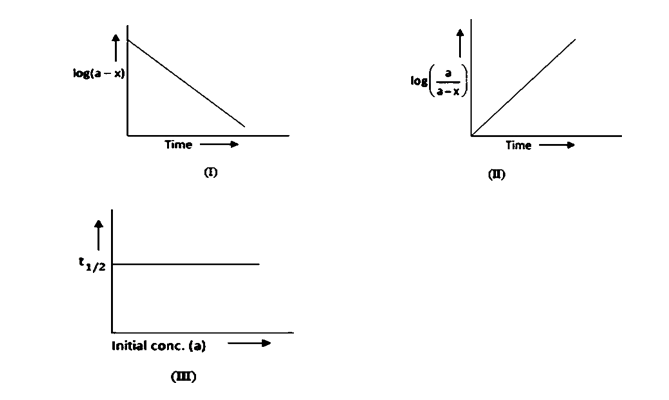In a first order reaction , on plotting a graph between t1/2 and concentration of reactant
A curve is obtained
A straight line is obtained having slope 45∘
A straight line is parallel to time axis
A straight line is parallel to the concentration axis
The correct Answer is:D
To solve the question regarding the relationship between the half-life (t1/2) and the concentration of reactant in a first-order reaction, we can follow these steps:
Step 1: Understand the relationship between half-life and concentration
In a first-order reaction, the half-life (t1/2) is given by the formula:
t1/2=0.693k
where k is the rate constant. Importantly, for a first-order reaction, the half-life is independent of the initial concentration of the reactant.
Step 2: Analyze the dependence of half-life on concentration
Since the half-life does not depend on the concentration of the reactant, we can conclude that regardless of the initial concentration (A0), the half-life remains constant. This means that as we change the concentration, the value of t1/2 does not change.
Step 3: Plotting the graph
When we plot a graph of t1/2 (on the y-axis) against the initial concentration of the reactant A0 (on the x-axis), we will observe that:
- Since t1/2 is constant and does not vary with A0, the graph will be a horizontal line.
- This line is parallel to the concentration axis (x-axis).
Step 4: Conclusion
From the analysis, we can conclude that the graph of t1/2 versus the concentration of the reactant in a first-order reaction results in a straight line that is parallel to the concentration axis.
Final Answer
The correct option is:
- Option 4: A straight line is parallel to the concentration axis.
---
In a first-order reaction, the half-life (t1/2) is given by the formula:
t1/2=0.693k
where k is the rate constant. Importantly, for a first-order reaction, the half-life is independent of the initial concentration of the reactant.
Since the half-life does not depend on the concentration of the reactant, we can conclude that regardless of the initial concentration (A0), the half-life remains constant. This means that as we change the concentration, the value of t1/2 does not change.
When we plot a graph of t1/2 (on the y-axis) against the initial concentration of the reactant A0 (on the x-axis), we will observe that:
- Since t1/2 is constant and does not vary with A0, the graph will be a horizontal line.
- This line is parallel to the concentration axis (x-axis).
From the analysis, we can conclude that the graph of t1/2 versus the concentration of the reactant in a first-order reaction results in a straight line that is parallel to the concentration axis.
The correct option is:
- Option 4: A straight line is parallel to the concentration axis.
Topper's Solved these Questions
- CHEMICAL KINETICSBOOK - AAKASH INSTITUTE ENGLISHCHAPTER - CHEMICAL KINETICSEXERCISE - ASSIGNMENT (SECTION A : Objective Type Questions)
50 Videos
- CHEMICAL KINETICSBOOK - AAKASH INSTITUTE ENGLISHCHAPTER - CHEMICAL KINETICSEXERCISE - ASSIGNMENT (SECTION B : Objective Type Questions)
20 Videos
- CHEMICAL KINETICSBOOK - AAKASH INSTITUTE ENGLISHCHAPTER - CHEMICAL KINETICSEXERCISE - Try Yourself
10 Videos
- CHEMICAL BONDING AND MOLECULAR STRUCTURE BOOK - AAKASH INSTITUTE ENGLISHCHAPTER - CHEMICAL BONDING AND MOLECULAR STRUCTURE EXERCISE - Assignment Section J (Aakash Challengers Questions)
10 Videos
- CHEMISTRY IN EVERYDAY LIFE BOOK - AAKASH INSTITUTE ENGLISHCHAPTER - CHEMISTRY IN EVERYDAY LIFE EXERCISE - Assignment ( SECTION - A)
45 Videos
Similar Questions
The rate constant of a first order reaction is proportional to the concentration of the reactant.
View SolutionThe rate constant of a first order reaction is proportional to the concentration of the reactant.
View SolutionThe rate constant of a first order reaction is proportional to the concentration of the reactant.
View SolutionIn a first order reaction A → B, if k is rate constant and initial concentration of the reactant A is 2 M then the half life of the reaction is:
View SolutionIn a first-order reaction A→B, if k is rate constant and initial concentration of the reactant A is 0.5 M then the half-life is:
View SolutionFor a first order reaction, the rate of the reaction doubled as the concentration of the reactant is doubled.
View SolutionWhich of the following is/are correct for the first order reaction ? (a is initial concentration of reactant, x is concentration of the reactant reacted and t is time)

View SolutionFor the reactionA→B, for which graph between half life (t1/2)and∈itialconcentration(a)oftherectantisgivenbelow<br><imga≤ocr_imageload∈g=lazysrc=https://d10lpgp6xz60nq.cloudfront.net/physics_images/NRA_PHY_CHM_JMA_C07_E01_022_Q01.pngwh=80%mx-autosty≤=background:white;><br>Hencegraphbetween-(d[A])/(dt) and time will be:
View SolutionThe rate of first-order reaction is 1.5×10−2Mmin−1 at 0.5M concentration of reactant. The half-life of reaction is
View SolutionIn a first-order reaction A→B, if K is the rate constant and initial concentration of the reactant is 0.5M, then half-life is
View Solution